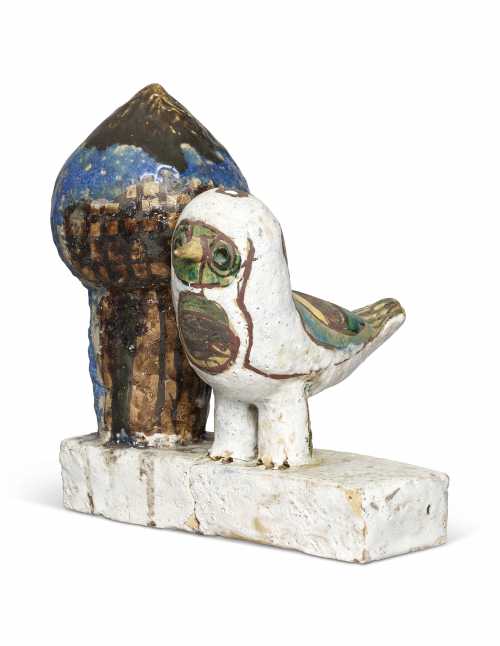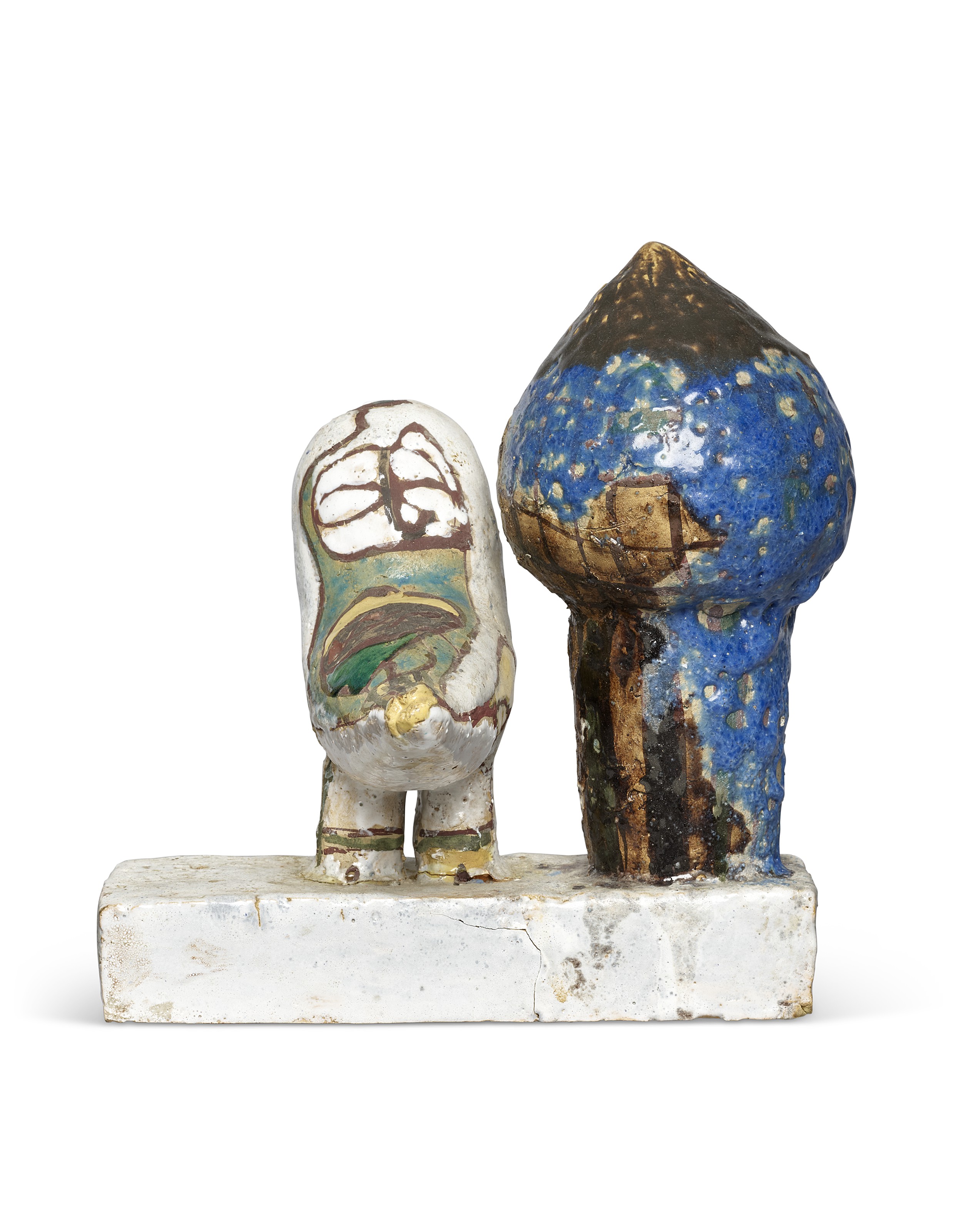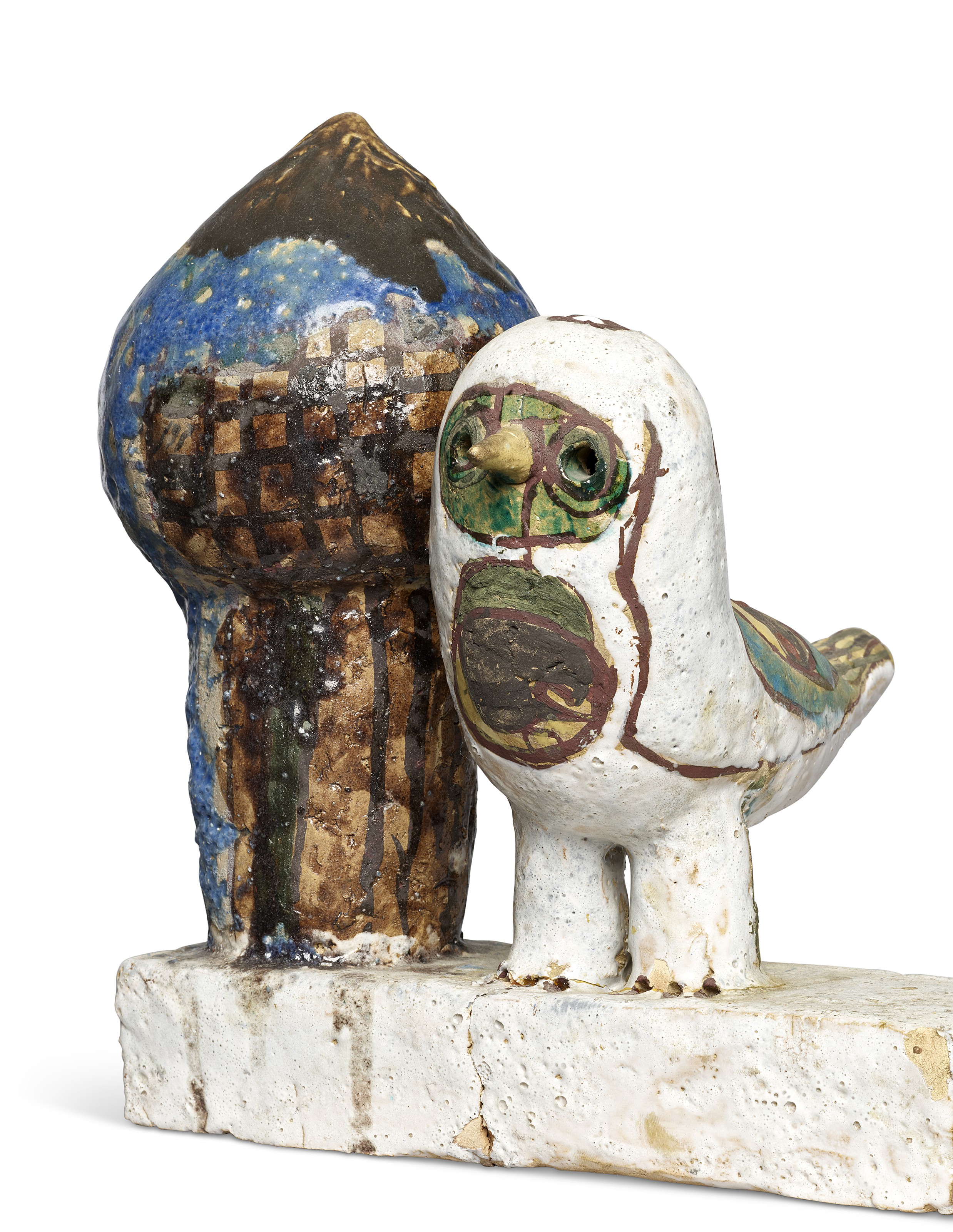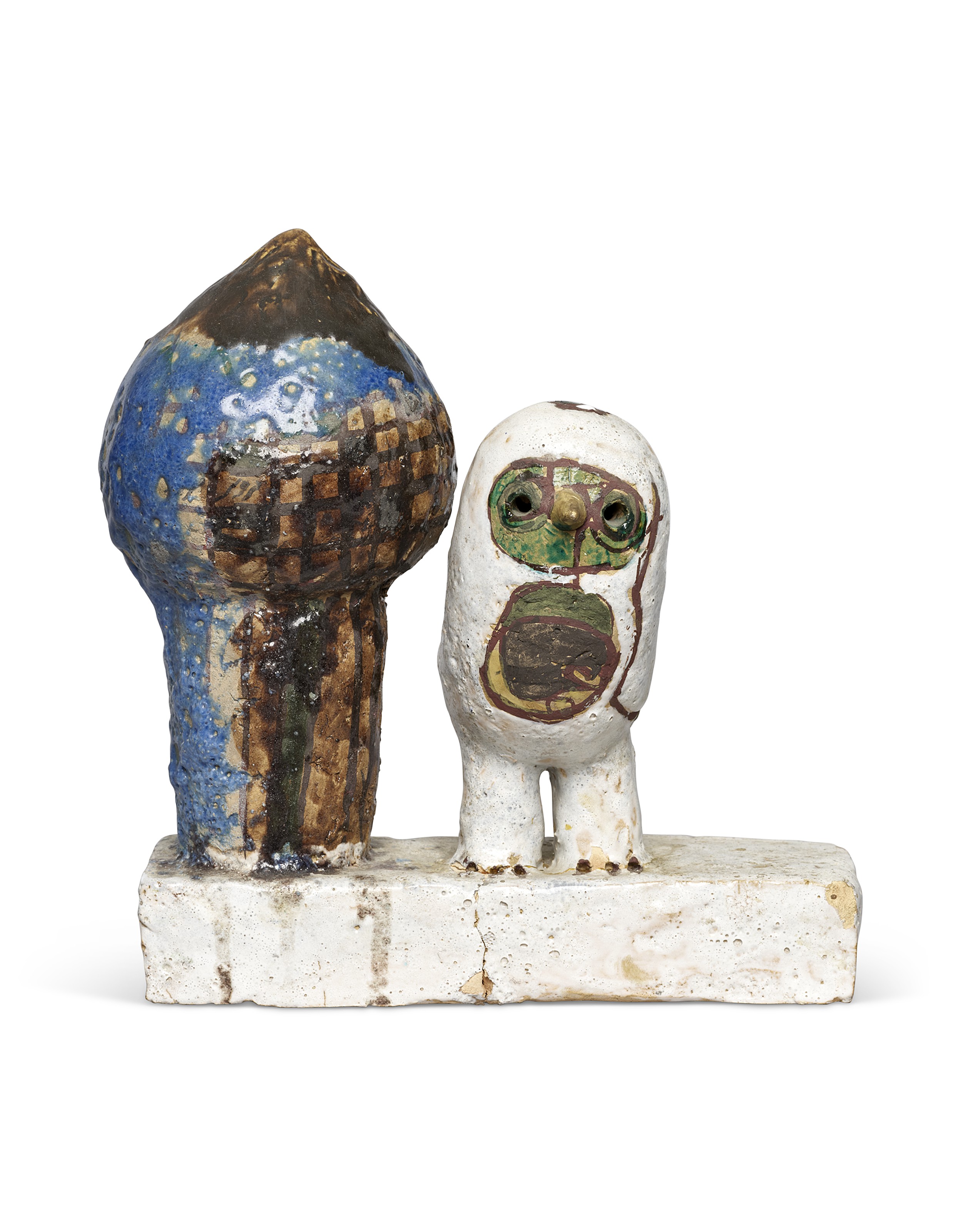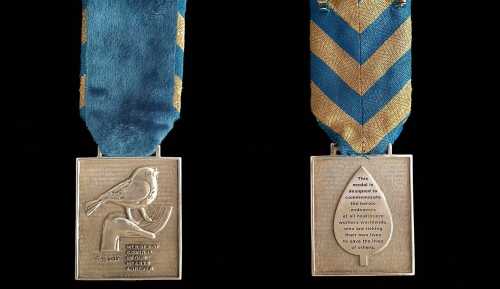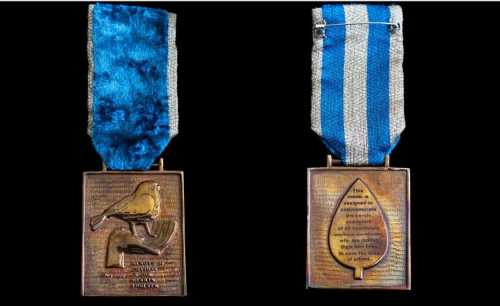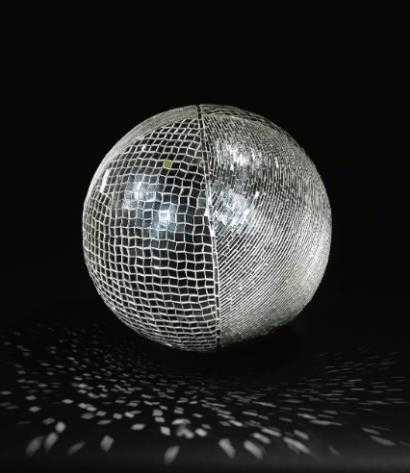- Bird and Tree 1967
- Glazed Pottery
- Sculpture
- 23.2 * 21 * 25 cm
20 October 2021
Estimation
£20,000
27,632 USD
-
£25,000
34,540 USD
Unsold
Art Fair Histories
Artwork Description
'Although my main work is in bronze and not in ceramics, since my youth I have been attracted to ceramics. At the time, ceramics were seen everywhere. Some were tiles and adorned the exteriors of shrines and mosques as well as the entrances of some of the bazaars. Others were handmade pots. During my childhood, Tehran lacked water pipes and people kept their drinking water in large pots. Every day horse-drawn wagons with water tanks passed by neighborhoods and filled up the women's ceramic pots.'
(The artist quoted in S. B. Sherill (ed.), Works of Parviz Tanavoli, Ceramics, Parviz Tanavoli, Tehran 2010, p. 5.)
Acclaimed for his sculptures, mainly in bronze, Tanavoli developed a passion for ceramic works from a young age, as they were dispersed throughout the urban landscape of his native Iran and in people's homes, as handmade ceramic pots, plates or bowls.
A delicate pair of ceramics are offered this season, which includes Bird and Tree and Bird (lot 41), depicting a symbol of the bird that has become a major cornerstone for the artist's practice, predicated by the modern use of traditional techniques and subjects found in Persian poetry.
When Tanavoli returned to Iran after training in Italy under Marino Marini, he didn't yet have a studio and so attended workshops in pottery factories including that of the Bureau of Fine Arts and used their material to make his first ceramic sculptures. A few years later in 1965, Tanavoli settled his own workshop in the north of the capital, establishing his bronze foundry and ceramic kiln where he produced the present works. Working mainly with bronze, Tanavoli focused on the art of ceramics for short periods throughout his career.
Birds have continued to play an integral role in Tanavoli's oeuvre, as evident across many works with reference to the cage, with Farhad and the poet, lovers, walls and trees. The symbol of the bird has also been a major cornerstone within Iranian art since ancient times, with the belief that imagery of birds within everyday materials link to spiritual salvation. As the artist states: 'In seven thousand years of Persian art, if we search for an enduring iconic image we may not find a better one than the image of the bird. From the prehistoric terra-cotta pots, to the latest handmade objects, the bird has been one of the most favorite subjects of artists and artisans. When I was collecting locks and other metal impliments, I noticed that many of them are made into bird shapes; and many others, though they were not made into a bird shape, ended with a bird head or a bird tail.'
For Tanavoli, the bird has accompanied his poets, lovers, trees and within locks and cages. While executing a few in bronze, he enjoyed producing these creatures in ceramics due to their flexibiliy in colours within that medium. Tanavoli produced examples of birds that were caged and restless nightingales, exemplifying the Sufi poetry of Persia that is sometimes spoken of as a captive bird that is constantly agitated and impatient, pining for a nameless beloved who, though not entirely unattainable, is won only after tortuous ordeals. The present works represent beautiful examples of his experimentation with birds, and while the creature in Bird and Tree is heavily grounded and appearing immobile within the thick base. the lone Bird (lot 41) is existing unfettered, and free - its sturdy yet delicate metal legs are met with a glassy texture in ethereal blues and greens.
Tanavoli is considered as a pioneer and co-founder of the Saqqakhaneh school that sought to incorporate religious symbols into art while reflecting the contemporary style and art that arose at the time in Western art. The name is derived from Saqqakhanehs that were folkloric religious structures which provided water for passersby to quench their thirst at no charge, and of which women would fill water within their ceramic pots. They also provided room for religious and talismanic rituals as many would come and attach different objects, most often locks to the grills of the fountains with hopes of a better future. Seen within this light, Tanavolis sculptures points to these symbolic links to belief, rituals and healing.
Tanavoli's career and artistic production have been recently celebrated internationally through major exhibitions at The Victoria and Albert Museum, London; Davis Museum, Wellesley College, Massachusetts; Tate, London; and the Grey Art Gallery, New York University, among others.
His works can be found in several important collections including the Museum of Modern Art, Vienna; the Ludwig Museum, Aachen, Germany; MATHAF: Arab Museum of Modern Art, Doha; The Grey Art Gallery, New York University, the City of Isfahan, and the City of Tehran.
More lots by Parviz Tanavoli
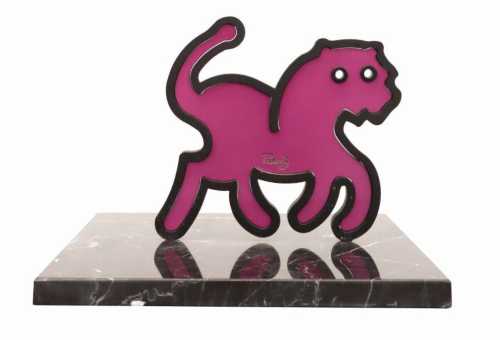
Untitled
Estimation
1,500,000,000﷼
2,481 USD
-
2,000,000,000﷼
3,309 USD
Realized Price
1,400,000,000﷼
2,316 USD
20%
Sell at
Sale Date
Smart Auction
-
2 August 2024
Realized Price
128,001 USD
Min Estimate
68,579 USD
Max Estimate
96,026 USD
Average Artwork Worth
+74.318%
Average Growth of Artwork Worth
Sales Performance Against Estimates
Average & Median Sold Lot Value
2021 - 2025
Performance vs. Estimate
2021 - 2025
Sell-through Rate
2021 - 2025
Similar Artworks

Untitled
Estimation
1,500,000,000﷼
2,481 USD
-
2,000,000,000﷼
3,309 USD
Realized Price
1,400,000,000﷼
2,316 USD
20%
Sell at
Sale Date
Smart Auction
-
2 August 2024
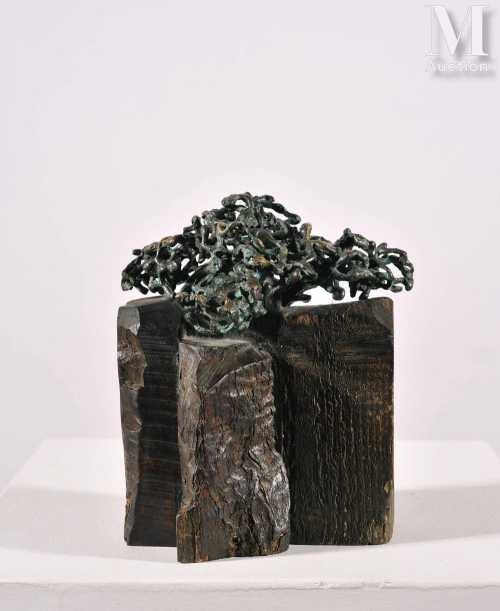
Untitled
Estimation
€3,700
3,949 USD
-
€5,500
5,870 USD
Sale Date
Millon & Associés
-
25 April 2024
